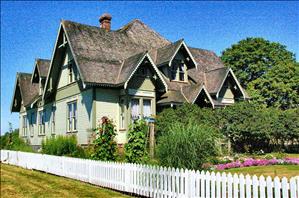Hovander Homestead Park, located just south of the Ferndale city limits, is a 333-acre farmstead that has been maintained to look much as it did in the first half of the twentieth century. Owned by Whatcom County Parks and Recreation, the park is a favorite hangout for families as well as history buffs who want to feel as though they’ve traveled back in time.
Hakan Hovander
Hovander (pronounced Ho-VAN-der) Homestead Park, located on the Nooksack River just outside Ferndale, is named after Swedish architect Hakan Hovander (1841-1915), an early Ferndale settler. Hovander’s personal history is as interesting as the park’s. He was born in 1841 in the village of Faraback in southern Sweden and sailed with his twin brother to America shortly after the end of the Civil War in 1865. After working as a builder in San Francisco, Portland, and Chicago for a few years, he returned to Sweden and studied architecture.
In 1879 Hovander married Louisa Leontine Johansdotter (1858-1936) and over the next 20 years they had seven children: Hugo (1880-1943), Elsa (1882-1961), Otis (1884-1979), Angelo (1889-1944), Charles (1893-1954), Ada (1895-1968), and Vera (1899-1929). Hovander enjoyed considerable success as an architect in Sweden, but in 1896 he and his family left the mother country on an almost round-the-world adventure, living in New Zealand, Seattle, and Ferndale, all within the space of two years.
In May 1898 Hovander bought a 60-acre farm on the east side of the Nooksack River just south of Ferndale for $4,000 (about $105,000 in 2011 dollars) and bought another 200 acres in 1900 and 1901. In the summer of 1901 he began building his home, perhaps the most interesting building on the property. Completed in 1903, the house is 6,800 square feet (counting the second floor and attic) and has three bedrooms, a library, a dining room, and a large kitchen on the first floor. The interior of its second floor was never finished -- there are various stories as to why -- but the big empty space came in handy for dances during the home’s first decades. The house has wooden ceilings and trim treated with linseed oil that still look fresh today (2011). It has gingerbread molding along the exterior eaves.
Hakan Hovander died in 1915. His children gradually drifted away from the farm, with the exception of Otis, who never married but instead remained with his mother until her passing in 1936. He inherited the property and stayed until 1969, when he sold it to Whatcom County Parks and Recreation for $60,000 (nearly $370,000 in 2011 dollars). Included in the sale were furnishings in the house, and while some of this furniture is still there today, other pieces have been replaced with similar period pieces. The interior walls and kitchen floor also have been replaced.
Step Into The 1930s
Whatcom County Parks and Recreation restored the house and other buildings and landscaped the property. In June 1971 Hovander Homestead Park was dedicated and quickly caught on with the public. Girls (later senior citizens) dressed in early twentieth-century clothing gave tours of the house, and demonstrations were also given of various chores, such as making bread in the kitchen’s big wood oven. In 1974 the site was placed on the National Register of Historic Places, and in 1978 received the National Trust for Historic Preservation award for the preservation of a significant and authentic historic site.
Today (2011) volunteers still give tours of the house, but they no longer dress in period clothing, and indeed, on some days they can’t be found to give tours; if you’re interested in exploring the house, it’s a good idea to call ahead to make sure it’s open. The house features three bedrooms on the first floor’s west side, with the library, dining room, and kitchen on its east side. All of the rooms are interesting in their own way, but the kitchen is probably the most fascinating. Step into the kitchen and you’re stepping into the 1930s, with period appliances and fixtures to add to the feeling. Only the original wooden floor has been replaced, with a modern floor.
You don’t need a guide to tour the property, which is an experience in itself. Just east of the house is a huge 10,900-square-foot red barn, built in 1911, and inside are some original farm implements dating from between 1900 and 1950. South of the house is an old 50-foot-tall observatory; climb the wooden stairs and admire the view from the top. The property also boasts more than a mile of frontage along the Nooksack River. In the summer barnyard animals are loaned to the farm for youngsters to enjoy, and the park is a favorite picnic spot for people of all ages. Flowers surround the house in the summer, and gardens dot the landscape during the growing season.
Hovander Homestead Park is the scene for all kinds of events -- weddings, family reunions, Civil War battle reenactments, and summer festivals, including the Scottish Highland Games each June. The park is open year-round.

